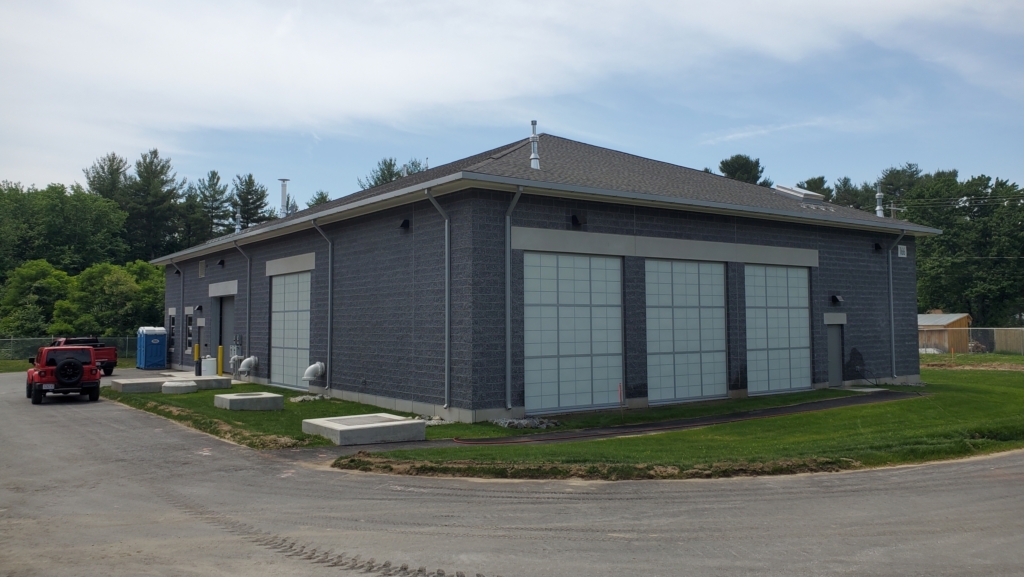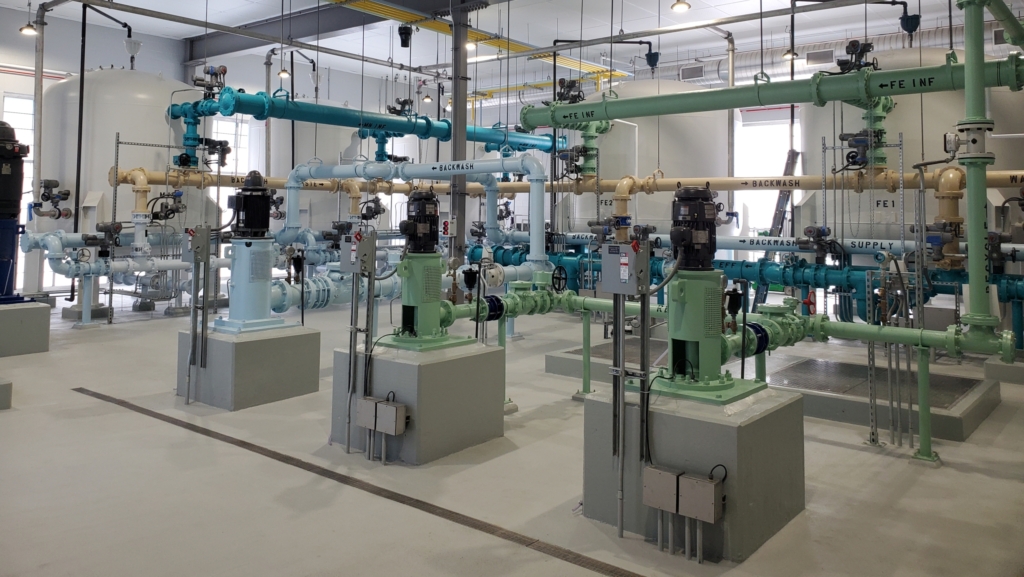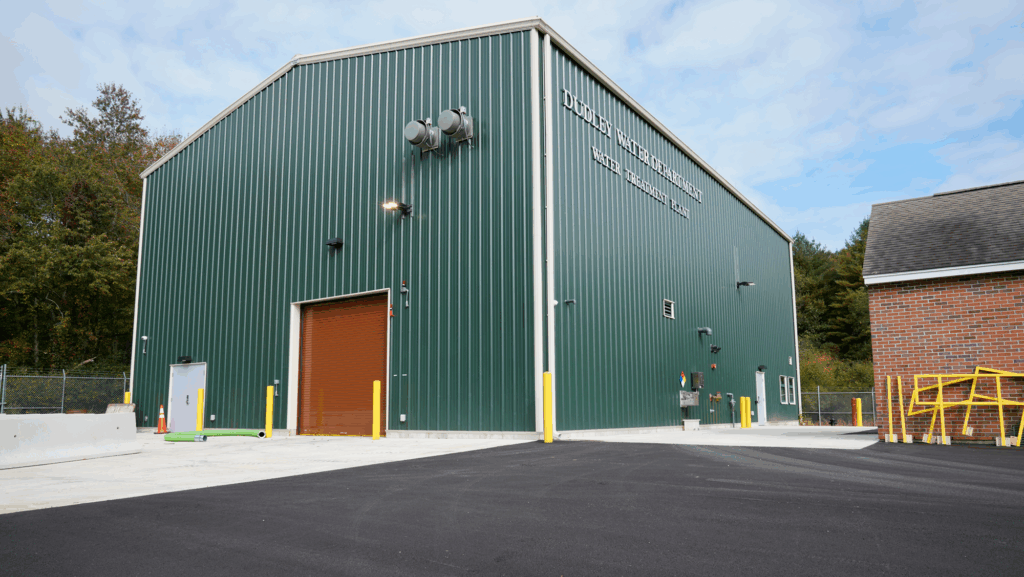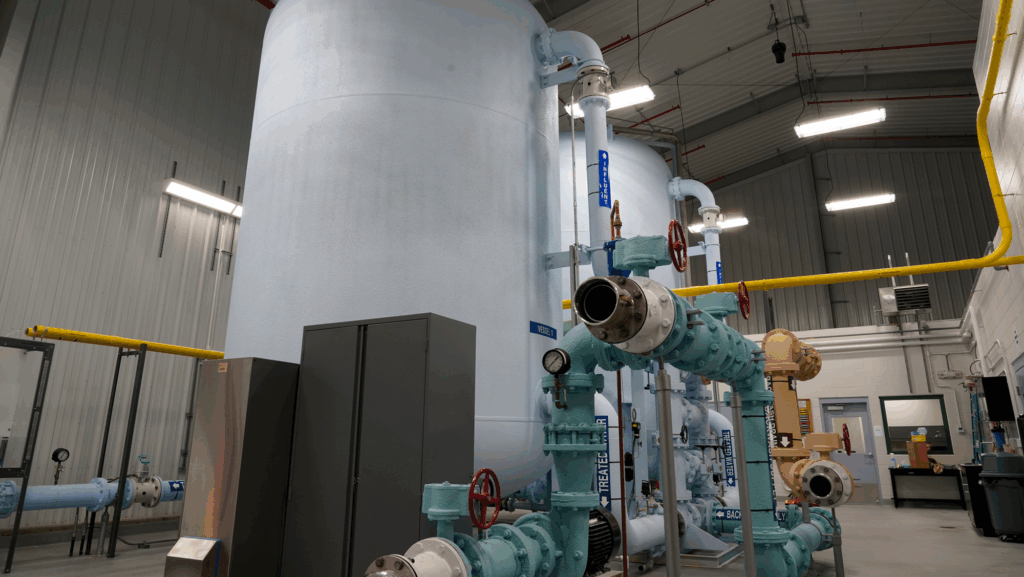Evolving Designs to Combat Emerging Contaminants
Our engineers have partnered with communities across the Northeast to respond to the growing threat of emerging contaminants, including per- and polyfluoroalkyl substances (PFAS). These contaminants pose a significant challenge to small water systems due to the financial and technical resources needed to implement advanced treatment technologies.
Below are two cases where our engineers collaborated with municipal or regional water utilities to design effective responses to emerging contaminants:
- The exterior of the finished building.
- Inside the treatment plant’s process room.
Tyngsborough Wellfield Iron/Manganese Treatment Facility
Owner: Dracut (MA) Water Supply District
The Dracut Water Supply District (DWSD) operates two wellfields in Tyngsborough (2.65 MGD, 7 wells) and New Boston (0.32 MGD, 2 wells). Several wells in the Tyngsborough facility were taken offline after testing had indicated that the well water contained heightened levels of iron and manganese. To restore the system’s pumping capacity and improve treatment capabilities, DWSD engaged our firm to design and permit a 2.65 MGD biological pressure filtration system to be used for the removal of iron and manganese from the Tyngsborough wellfield.
The design for the treatment facility includes sizing and layout of a biological filtration process with the ability for future expansion for PFAS treatment, a recycle system to minimize process waste streams, and residual drying beds to manage the materials being removed. Chemical feed systems for potassium hydroxide, calcium hypochlorite, sodium fluoride, and phosphate were also designed. This project was funded by the MassDEP Drinking Water State Revolving Fund (DWSRF) program and is now fully constructed and operational. Our firm is currently working on the design of a treatment system expansion to address PFAS contamination in the Tyngsborough Wellfield.
 Project Manager Mary Danielson recently presented on this project at the New England Water Works Association (NEWWA) Spring Conference.
Project Manager Mary Danielson recently presented on this project at the New England Water Works Association (NEWWA) Spring Conference.
When asked about her takeaways for designing drinking water facilities in a changing regulatory environment, she had this to say:
“It’s important to build flexibility into a design to accommodate future regulatory changes and emerging contaminants. Equally critical is pilot testing treatment systems under real-world conditions to ensure performance reliability and regulatory compliance before full-scale implementation.”
- Exterior of the finished treatment facility.
- The permanent treatment facility uses two GAC treatment vessels, incorporating the vessel from the temporary system.
Dudley (MA) Temporary & Permanent PFAS Treatment
Owner: Dudley Water Department
The Town of Dudley’s Water Department operates four active water wells, Well #3, Well #6, Well #7, and Well #8. In 2019, PFAS were detected in Well #3, prompting a three-phased project to centralize PFAS treatment for the Town’s entire water system.
In the first phase, our engineers assisted the Town with temporary measures to reduce PFAS concentrations in the groundwater supplies, including the design and construction of a water main from Well #7 to temporarily blend with water from Well #6. In the second phase, a temporary PFAS treatment system was designed, utilizing a granular activated carbon (GAC) treatment vessel at Well #7.
The final phase included construction of the permanent treatment plant, which incorporates the previous temporary PFAS vessel, as well as one new 12-foot-diameter GAC vessel. Raw water from all the wells is routed to the new PFAS WTP through new water mains and combined into a single plant influent line. The water produced from this WTP contains non-detectable levels of PFAS6, which are well below the state and federal limits.
 Senior Engineer Derek Belanger recently published an article in the Journal of the New England Water Works Association about this project.
Senior Engineer Derek Belanger recently published an article in the Journal of the New England Water Works Association about this project.
His takeaways on designing similar projects for small drinking water systems:
“To prepare for the challenge of emerging contaminants like PFAS, small water systems can adopt a proactive and strategic approach that includes regular monitoring, participation in regional or state-level contaminant tracking programs, and staying informed on evolving regulations. Establishing partnerships with technical assistance providers and leveraging grant or low-interest loan programs can help offset costs.”
Tags: drinking water, PFAS, pfas treatment, thought leadership, Water






